The retail industry is flush with opportunities for employment. But without a compelling retail resume, you won't be able to turn these opportunities into a job offer. Follow our guide and discover resume tips, real-life samples, and detailed examples that will make your resume irresistible for recruiters.
In this guide, we’ll take you through the essential steps for tailoring a resume for retail. Keep reading to learn all about how to:
- Select the correct resume format for your experience level in retail
- Write a compelling resume summary highlighting your retail strengths
- Choose key retail skills to include on your resume
- Use descriptive bullet points to optimize your work experience section
- Properly display your education and relevant certifications
- Access top resources for job-seeking retail professionals
Still looking for a job? These 100+ resources will tell you everything you need to get hired fast.
1. Select the correct resume format for your experience level in retail
The first big decision to make when writing a retail resume is what resume format to use.
Resume formats differ from one another mainly in which section they emphasize the most. Thus, the resume format that will best suit your needs is highly dependent on your experience level.
Here are the 3 main types of resume formats and the purposes they serve:
- Reverse-Chronological: This resume focuses on work experience, listing your most recent job first and working backward from that point. With this format, the work experience section will be the largest and most central section on the document.
- Functional: The functional resume is often used by students or recent graduates, as it removes the focus from work experience. Instead, this resume focuses on education, skills, certifications, and unpaid experience, making it a great time for first-time or entry-level applicants.
- Hybrid: The hybrid format combines elements from both the reverse-chronological and the functional resumes. It distributes focus more evenly between all sections, rather than having one section be a focal point. This format is often used by applicants with limited relevant experience, those who are changing career paths, and those with large gaps in their work history.
The reverse-chronological resume is typically considered the standard and is expected by most employers. However, if you lack relevant work experience, one of the alternative formats can help you create a more effective resume that highlights your strengths rather than your experience shortcomings.
2. Write a compelling resume summary highlighting your retail strengths
A resume summary is a brief statement that starts out your resume by introducing you to the employer. In this summary, you should detail your most important skills, specializations, accomplishments, or any other factors that help you stand out from competing applicants.
To illustrate how to create a well-written resume summary, we have provided an example of a weak retail resume summary followed by a corrected example and explanation.
Incorrect retail resume summary example
Retail Worker with 2 years of experience in department stores. Excellent customer service skills and upselling techniques. Responsible for a significant increase in seasonal sales in a previous temporary position, which led to the winning of a staff award at the company.
Why is this Incorrect?
When writing a resume summary, you want to include as many specific and quantifiable details as possible. For instance, when the applicant says they were responsible for a significant increase in sales, they should provide the exact percentage and more contextual information regarding the type of sales being made.
Corrected retail resume summary example
Talented Retail Sales Associate with 2+ years of experience working in major department stores. Increased holiday sales by over 50% at most recent position through the application of exceptional customer service and upselling techniques. Recipient of company’s “Holiday Sales MVP” award in 2019 & 2020.
Why is this Correct?
This corrected example offers much more specific details, as well as using more engaging and compelling language. The details provided have the context needed to make a lasting impact on employers and show the value the applicant can bring to a company.
3. Choose key retail skills to include on your retail resume
No matter what job you are applying for in retail, it is crucial to show employers through your resume that you have a diverse skillset with many different abilities. This is best accomplished by including both hard and soft retail skills on your resume.
Hard skills are technical abilities that you learn through training and education, while soft skills are interpersonal abilities that deal with how you communicate and work with other people. Soft skills can be both inherent and learned.
Below, we have provided 10 examples of both hard and soft skills that help enhance your retail resume:
The best hard skills to put on your retail resume
- Inventory management
- Money handling and financial transactions
- Point of sale (pos) systems
- Basic accounting and bookkeeping
- Product demonstrations
- Suggestive selling
- Upselling techniques
- Product stocking
- Opening and closing procedures
- Sanitation and safety standards
Effective soft skills for your retail CV
- Customer service
- Verbal communication
- Patience
- Adaptability
- Positive attitude
- Active listening
- Attention to detail
- Conflict resolution
- Time management
- Multi-tasking
4. Use descriptive bullet points to optimize your work experience section
When writing your work experience section, there is often a lot of information to cover in a relatively small amount of space. This means you need to select the very best responsibilities and accomplishments from your previous positions to highlight in your descriptions.
The key to writing the optimal work experience section is to keep your words succinct and organized. Bullet points work excellently for this purpose, helping to give your work experience section greater readability and visual appeal.
Here is an example of a work experience entry from a retail resume
Macy’s, Denver, CO
Retail Sales Associate
August 2016 to May 2019
- Averaged 125% of sales goals quarterly for 2 consecutive years.
- Managed inventory of 100+ items, including setting up store display windows and in-store merchandise displays.
- Assisted an average of 50 customers per day, providing personalized recommendations for products that contributed to high sales goal achievement.
5. Properly display your education and relevant certifications
In general, the minimum education requirement to work in retail is a high school diploma or GED.
However, a two or four-year degree in a related field, such as sales management or retail management, can not only boost your resume’s competitive edge but also help you gain access to higher-level positions.
Additionally, if you have any certifications that are relevant to the retail industry, including this on your resume is key and will show employers the dedication and extra value you offer as an employee.
Here is an example of a well-crafted education section on a retail resume
Howard Community College, Columbia, MD
Associate’s Degree in Retail Merchandising
Graduated: 2018
Certifications
- Management Certificate — Montgomery College
6. Include relevant extra sections in your retail resume
Incorporating relevant extra sections in your retail resume is of great significance when aiming to stand out in a competitive job market.
While your work experience and skills are crucial, extra sections provide an opportunity to showcase additional qualifications and experiences that set you apart from other candidates.
Including sections such as certifications, professional affiliations, volunteer work, or relevant projects can greatly enhance your retail resume.
Certifications, such as customer service or sales training, demonstrate your commitment to professional development and showcase your expertise in specific areas.
Here's an example of how to properly list certifications in your retail resume
Certifications
- Certified Sales Associate, Retail Association of America
- Completed comprehensive training program covering effective sales techniques, customer service best practices, and product knowledge.
- Demonstrated proficiency in providing personalized shopping experiences, building customer relationships, and driving sales.
- Implemented upselling strategies resulting in a 15% increase in average transaction value.
- Earned recognition for consistently achieving monthly sales targets and delivering exceptional customer satisfaction.
7. Top resources for job-seeking retail professionals
As you put the finishing touches on your customized retail resume, it's time to dive into the job search. Below are some excellent resources to kickstart your job hunt:
- Industry-specific job boards: Websites, such as AllRetailJobs.com, RetailChoice.com, or RetailGigs.com are dedicated exclusively to the retail industry, featuring jobs from various retail sectors including store management, merchandising, and corporate positions.
- Indeed: Indeed is a job site with a very broad focus. So, use filters to narrow down searches to roles that best fit your skills and experience.
- Glassdoor: Think of it as a window into company cultures, salaries, and job listings. It's an invaluable tool for retail professionals to research potential employers.
- LinkedIn: This isn't just a networking site, LinkedIn also provides job listings, company insights, and the ability to connect with industry professionals and groups focused on retail.
- Professional associations: Professional associations play a pivotal role in providing networking opportunities, industry insights, continued education, and advocacy for retail professionals. For, example, you can join the National Retail Federation (NRF) or the British Retail Consortium (BRC).
- Retail agencies: These recruitment agencies often have deep industry connections and can offer personalized job search assistance. Just look at Michael Page Retail, Hays Retail, or 24 Seven Talent.
- Courses and certifications: Online courses and certifications on platforms like Coursera, edX, and LinkedIn Learning offer flexible learning opportunities for retail professionals who want to improve their competitiveness in the job market.
Don't forget that a job search is a marathon not a sprint! And you won't get far in this race without an outstanding retail resume. Make yours now!
Retail Resume FAQ
How can I highlight my achievements in retail on my resume?
To really sell your abilities, quantify your achievements with numbers and percentages whenever possible. For example, "Increased sales by 20% through effective customer service strategies" or "Reduced inventory shrinkage by 15% through improved loss prevention techniques”.
How can I make my retail resume ATS-friendly?
Use a simple, clean format without graphics or tables, which can confuse ATS software. Stick to standard fonts like Arial or Times New Roman, and include keywords from the job description. Then, save your resume as a Word document or PDF to ensure it's readable by most ATS systems.
Should I include references on my retail resume?
The standard practice is to leave references off your resume. Instead, note that they are available upon request and have them ready in a separate document. This saves space for more critical content and allows you to prepare your references for potential contact.
How important is the "interests" section in a retail resume, and what should I include?
An "interests" section can add a personal touch to your resume, but it should be concise and relevant. Include interests that demonstrate skills or qualities valuable in retail, such as team sports (teamwork), blogging about fashion (communication skills and passion for the industry), or volunteering at community events (customer service and community engagement).
How should I format my retail experience on my resume?
Use a reverse-chronological format to list your most recent job first. For each position, include your job title, the company's name, location, and dates of employment. Additionally, under each job, write bullet points detailing your responsibilities and achievements.

![Representante de ventas en Adidas currículum ejemplo [ES]](png/thumbnail-6.png)


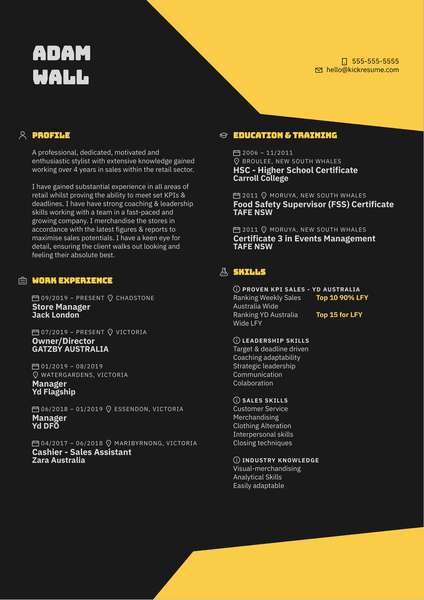

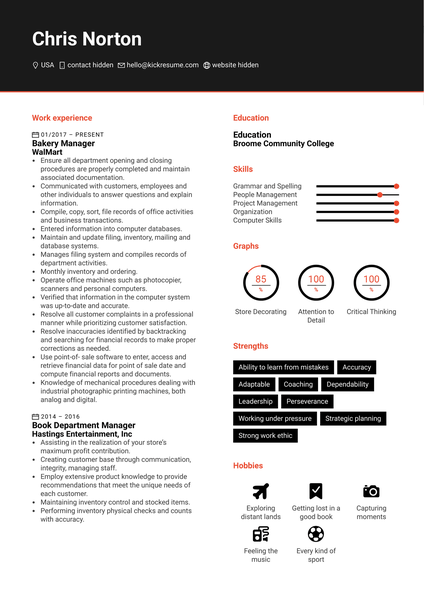

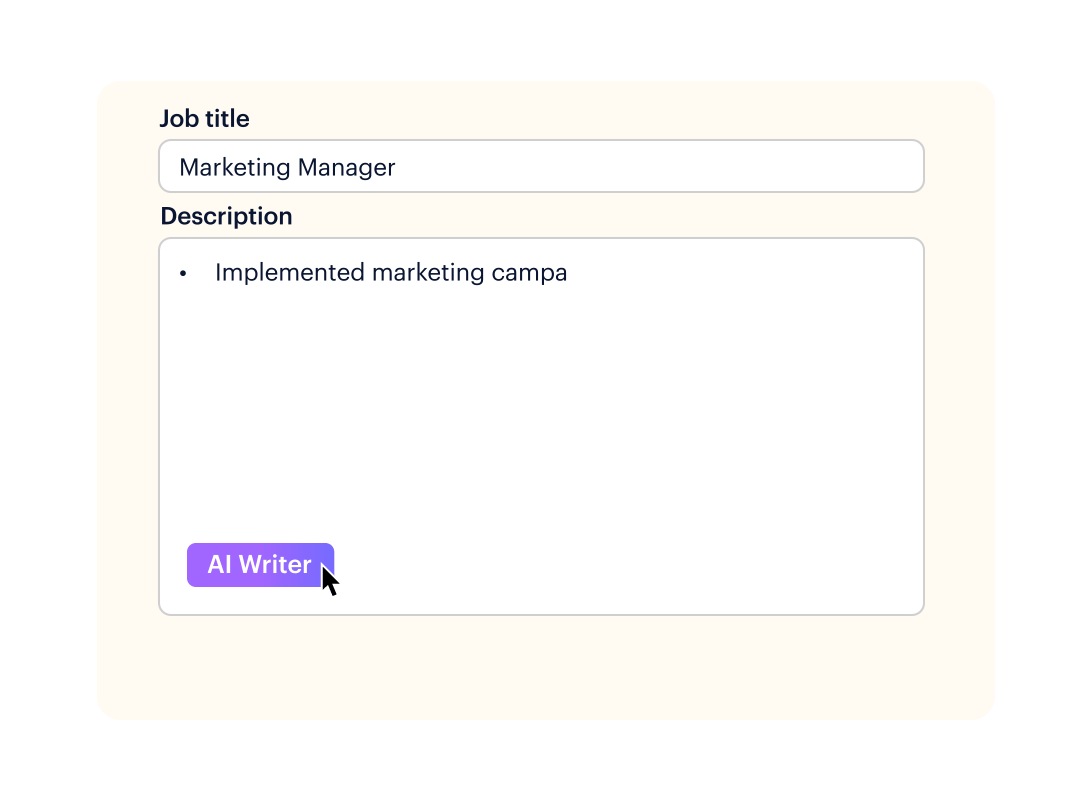

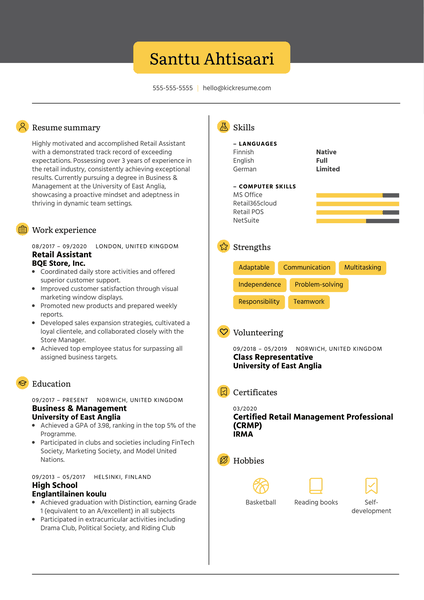


![Nike Retail Brand Specialist [SV]](png/thumbnail-592.png)

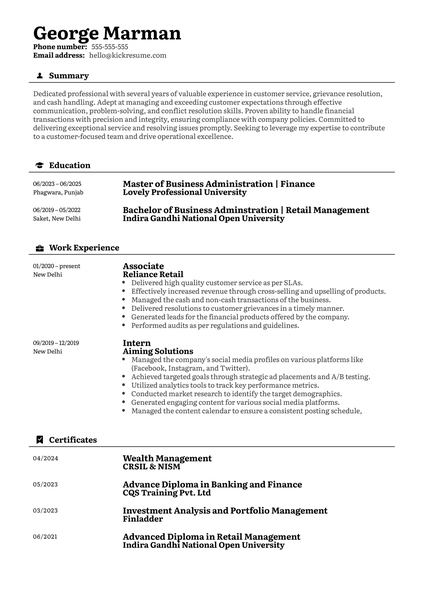

![Analista con experiencia en minorista currículum ejemplo [ES]](png/thumbnail-594.png)



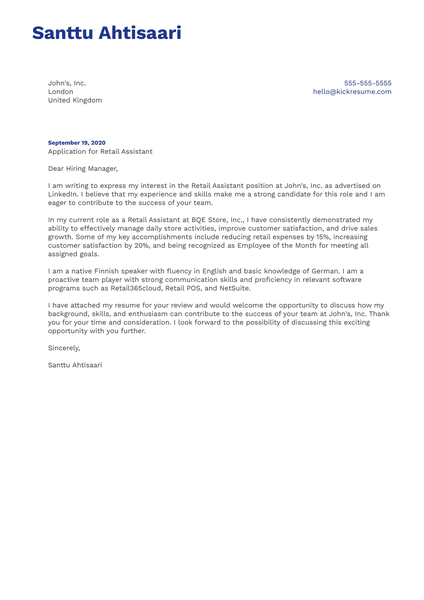

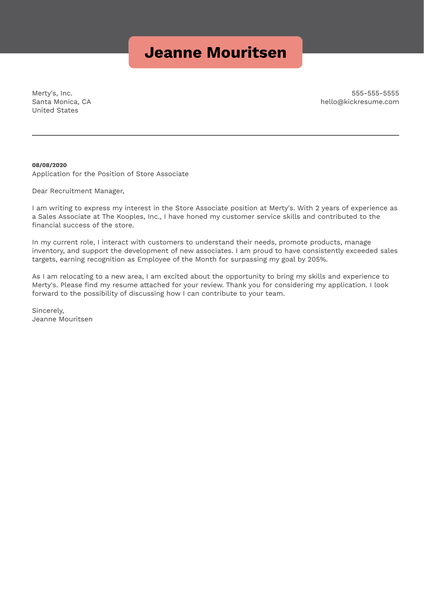
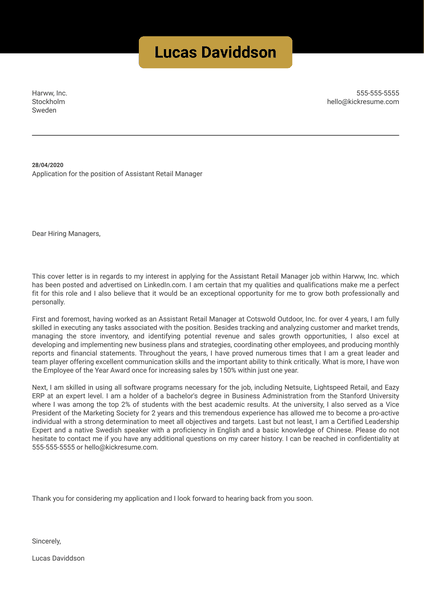
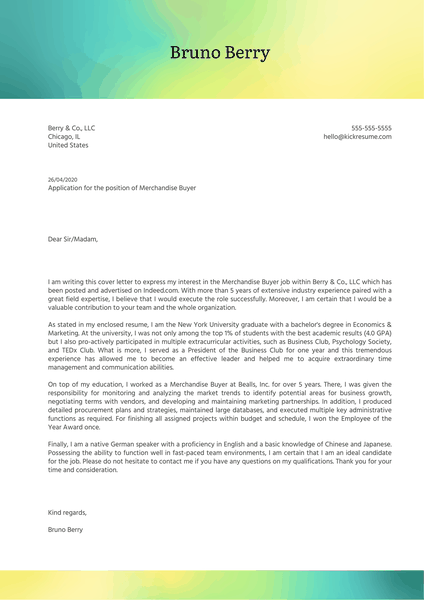
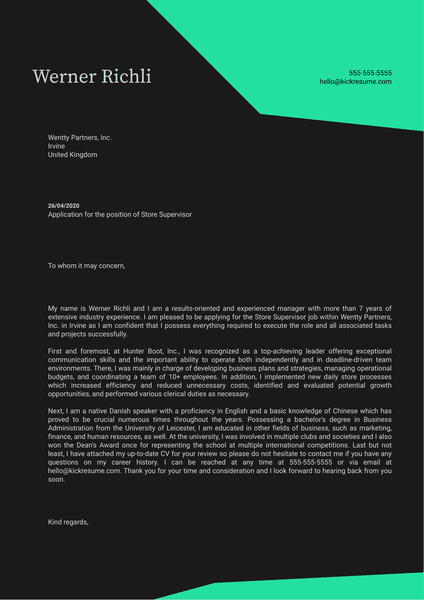
![How to Write a Professional Resume Summary? [+Examples]](https://d2xe0iugdha6pz.cloudfront.net/article-small-images/i-Profile.svg)
![How to Put Your Education on a Resume? [+Examples]](https://d2xe0iugdha6pz.cloudfront.net/article-small-images/i-Collage-Universities.svg)
![How to Describe Your Work Experience on a Resume? [+Examples]](https://d2xe0iugdha6pz.cloudfront.net/article-small-images/Experience.svg)


